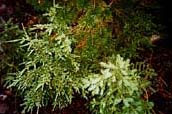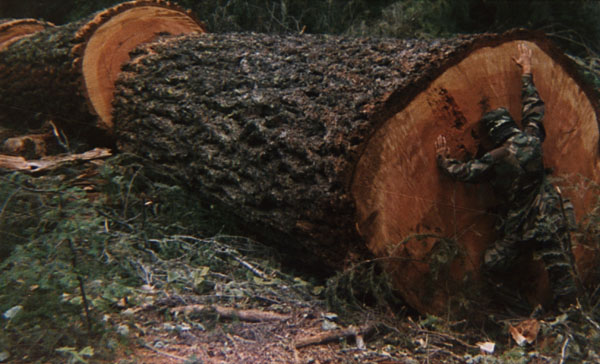 Waldo Lake Forests
Waldo Lake Forests

 The Waldo
Lake Wilderness is located in the Willamette National Forest.
The 37,162 acre Waldo Lake Wilderness ranges in elevation from 2,800 to
7,144 feet. Waldo Lake, the obvious namesake of the wilderness, is one of
the cleanest large lakes in the world. It has no permanent inlet to bring
nutrients into the lake for plant growth. A secchi dish, a visual tool
used to measure the clarity of water, can be seen at a depth of 125 feet. It's
unfortunate we didn't have the opportunity to see it. The forests around
Waldo are also quite interesting, however. The Waldo
Lake Wilderness is located in the Willamette National Forest.
The 37,162 acre Waldo Lake Wilderness ranges in elevation from 2,800 to
7,144 feet. Waldo Lake, the obvious namesake of the wilderness, is one of
the cleanest large lakes in the world. It has no permanent inlet to bring
nutrients into the lake for plant growth. A secchi dish, a visual tool
used to measure the clarity of water, can be seen at a depth of 125 feet. It's
unfortunate we didn't have the opportunity to see it. The forests around
Waldo are also quite interesting, however.
 Excluding
the lake, the wilderness is 98% forested. The High Cascades are
mostly mountain hemlock, Douglas-fir, Lodgepole pine, and some true fir.
Some of the other trees we saw in the Waldo lake area were Pacific Silver Fir
Abies amabilis, Grand Fir Abies grandis, and a Ponderosa
Pine Pinus ponderosa. Excluding
the lake, the wilderness is 98% forested. The High Cascades are
mostly mountain hemlock, Douglas-fir, Lodgepole pine, and some true fir.
Some of the other trees we saw in the Waldo lake area were Pacific Silver Fir
Abies amabilis, Grand Fir Abies grandis, and a Ponderosa
Pine Pinus ponderosa.
 These
high elevation forests are slow growing and covered with snow much of
the year. This has limited the amount of logging that has occurred in these
stands, which makes them good areas to observe landscape level patterns of
fire disturbance. Under the current wilderness distinction no logging is
allowed, of course. A significant amount of US wilderness areas are not
forested, rock and ice or desert, or they contain forests like those at
Waldo that are of marginal commodity value. You just will not see many
trees the size of the one to the right in wilderness areas. Most of these
very large trees were cut down first because of their size and because
these larger trees were generally in bottom-lands and close to waterways
which were used for transportation. These
high elevation forests are slow growing and covered with snow much of
the year. This has limited the amount of logging that has occurred in these
stands, which makes them good areas to observe landscape level patterns of
fire disturbance. Under the current wilderness distinction no logging is
allowed, of course. A significant amount of US wilderness areas are not
forested, rock and ice or desert, or they contain forests like those at
Waldo that are of marginal commodity value. You just will not see many
trees the size of the one to the right in wilderness areas. Most of these
very large trees were cut down first because of their size and because
these larger trees were generally in bottom-lands and close to waterways
which were used for transportation.
 One of the most interesting organisms we covered in the Waldo Lake forests
was Laminated Root Rot. The disease is a typical
root and butt rot, which causes expanding centers of mortality.
Laminated Root Rot is restricted in distribution to the
PNW and Inland Empire area, but it occurs on a variety of important
conifers here and causes very significant losses.
The spores of this
fungus don't seem to play much of
a role in its distribution. All the inoculum of significance comes from
infected stumps and roots. It
can't grow through soil but root contacts and grafts are
sufficient to get it around.
One of the most interesting organisms we covered in the Waldo Lake forests
was Laminated Root Rot. The disease is a typical
root and butt rot, which causes expanding centers of mortality.
Laminated Root Rot is restricted in distribution to the
PNW and Inland Empire area, but it occurs on a variety of important
conifers here and causes very significant losses.
The spores of this
fungus don't seem to play much of
a role in its distribution. All the inoculum of significance comes from
infected stumps and roots. It
can't grow through soil but root contacts and grafts are
sufficient to get it around.
There are two forms of the pathogen, one on western red cedar and the other
on Douglas-fir. Phellinus weirii, the traditional name, went with the one
on cedar and the more important one on Douglas-fir is called Phellinus
sulphurascens. There
is a range of resistance to these diseases. Pines, cedars and hardwoods are
most resistant (to the Douglas-fir form).
Although the disease causes high fatality in Waldo Lake forests, it
contributes to forest diversity. Furthermore, it provides refugium (seed
source) for both early and late successional species. Promotion of species
diversity by disease, however, is not limited to Phellinus sp.
Moderate frequency disturbance in general helps maintain and increase
species diversity in many ecosystems. In the Cascade forests disease, fire,
and insects are important parts of functioning ecosystems. We have much to
learn about how these ecosystem elements interact with other forest ecosystem
functions and organisms. We do know, however, that functioning forest
ecosystems are vital to our well-being. I hope you enjoyed this short tour
of these issues and you are inspired to learn more.

Related Links
Forest & Shade
Tree Pathology State University of New York
Ecological
Subregions of the US
 Waldo Lake Forests
Waldo Lake Forests

|

